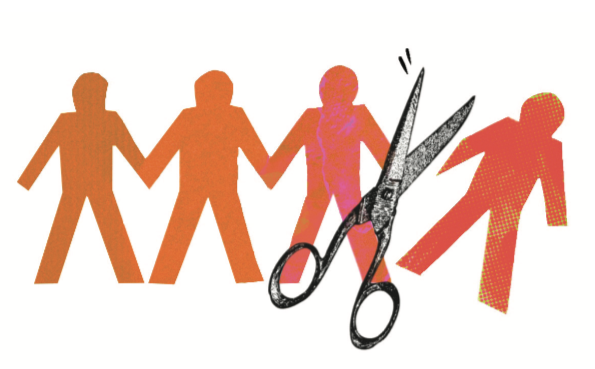The primary determinant for the exclusion of those living with mental health conditions has to do with our unchecked prejudicial and discriminatory stigmatization of them.
A FRANCIS OFM
The number of individuals living with mental health conditions
in a shadow pandemic of mental health is alarmingly on the rise. The harrowing words of Dr T A Ghebreyesus, the Director General of WHO, ‘Everyone’s life touches someone with a mental health condition’ hold a mirror image of the unfolding mental health crisis.
More people contracting mental health conditions would mean more people are being succumbed to social stigma, neglect and exclusion, besides suffering from an illness(es) that impairs their mental health. Social stigma, neglect and exclusion make the sick get much sicker.
Despite the reliable scientific data on the benefits of social inclusion in the treatment
of people with mental health conditions, we turn a deaf ear to it. Social inclusion starts with destigmatising of mental health conditions through genuine human acts of caring and compassion.
The Plight
The plight of the people with mental health conditions, whether it was of Lorry (pseudonym) from my childhood memories who aggressively chased after those who triggered her, or our favourite ‘crazy fiddler’ who sits on the roof in the popular Broadway musical, Fiddler on
the Roof, or of anyone else, has never been
any different from one of explicit neglect
and exclusion. On that miserable fate which majority of them share, one small differing note might be added that the two broad categories that comprise the world’s 970 plus million individuals with mental health issues, the category of the ‘any mental illness’ (AMI) are slightly more fortunate than the ‘severe mental illness’ (SMI).
The AMIs, depending on the intensity of the illness and the treatment accessibility, are able to camouflage their illness, and function to the best of their abilities. Some extremely versatile personages who hold the beacon of hope in this category are, Vincent Van Gogh, Michelangelo, Abraham Lincoln, Virginia Woolf who though suffered from mental illness, still left their indelible footprints on human history.
Sadly, the SMIs, can neither camouflage their illness, nor manage their lives. Living in dejection and friendlessness, they wander on the streets, as social castaways scavenging from the household throwaway food to the filthy wayside garbage bins. Eventually they die a premature death, as much as two decades early, due to a preventable physical illness, documents WHO. It is estimated that eight million people die of mental illness, each year.
Our Bias Causes Social Exclusion
The only treatment approach prevalent for SMIs until the 1960s, was to lock them up in mental health asylums. This practice focused not on providing them with quality treatment, but on ensuring safety and protection of the public.
Mental health asylums are known for
their horrific living conditions; they are not only smelly, filthy, and crowded, but also not sufficiently conducive to heal the individual, notes Dr A J Frances, the chair of the DSM-
IV Task Force. He writes, ‘No surprise that it caused the emergence of the worst symptoms in people who were already troubled by mental illness.’ Relating to his personal experience of witnessing their degradation, he calls asylums as ‘disgraceful snake pits’!
Studies highlight that the primary determinant for the exclusion of those
living with mental health conditions has
to do with our unchecked prejudicial and discriminatory stigmatisation of them that they are unpredictably dangerous, aggressive, violent, prone to criminality, and many more discriminatory misconceptions we hold. Contrary to our implicit bias, data shows
that the number of individuals with SMIs who become the victims of violence is much higher than the number of them becoming the perpetrators!
An Unrealised Dream of Social Inclusion
The dream of social inclusion and deinstitutionalisation in the management
and treatment of the individuals with mental health conditions was at the heart of the reform intended in the 1960s in different parts of
the world. Replacing of psychiatric asylums with community mental health centres were the immediate plan of action in realizing
this dream. Instead of locking them up in the asylums, let them live and get the care in the community. The success of this reform required the widespread decentralizing of psychiatric facilities into community-oriented clinical centres in cities, towns and villages.
Ironically, majority of the countries that envisioned the promise of the theory of deinstitutionalisation, hurriedly abolished the asylums, but fell short on their commitment to building up the community mental health centres. The result is, more individuals with SMIs are pushed on the streets, and in prisons.
Healing by Caring and Social Inclusion
Dispelling our misconceptions, which is fundamental to the process of inclusion, is not an easy task. These are so deeply imprinted in us, like in a stone-carving. But to begin with, we can focus on a tiny step of perspective change, like the one suggested by Alisa Roth, the author of the book, Insane: America’s Criminal Treatment: ‘One that goes from seeing people as inherently dangerous to treating them as human beings in need of help.’ With our awareness of their shared humanity, we have already advanced in the process of inclusion.
In the same vein, Dr Frances who has done extensive research on mental health, suggests an effective way we could engage in the process of their social inclusion. While critiquing on the lack of political will in providing adequate care and housing, he prescribes to people to engage in the act of social cure. As a psychiatrist, educator, and author he writes his experience, convincingly: ‘We can heal by simple human acts of caring and inclusion’.
The change of perspective, and the social cure, both, sound very promising. Still, a great deal of uncertainty will remain in the plight of people who live with mental health conditions, until the policymakers of the State invest in providing appropriate community mental health centres, and decent housing for the people.
∎